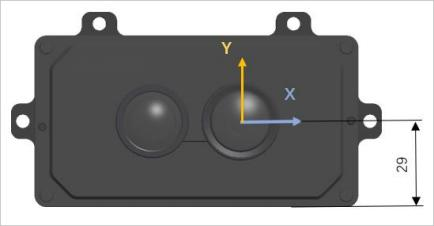2025-11-21
Unlocking the Future: The Role of SPAD TOF Sensor Modules in Robotics
Table of Contents
- 1. Introduction to SPAD TOF Sensor Technology
- 2. Understanding SPAD TOF Sensors: An Overview
- 3. Working Principle of SPAD TOF Sensors
- 4. Applications of SPAD TOF Sensors in Robotics
- 5. Advantages of SPAD TOF Sensors in Robotic Systems
- 6. Challenges and Limitations of SPAD TOF Sensors
- 7. Future Trends in SPAD TOF Sensor Technology
- 8. Conclusion
- 9. Frequently Asked Questions (FAQs)
1. Introduction to SPAD TOF Sensor Technology
The emergence of **SPAD (Single-Photon Avalanche Diode)** Time-of-Flight (TOF) sensor modules is revolutionizing the landscape of robotics. These sensors offer unrivaled precision in distance measurement, making them indispensable for various robotic applications. As robots increasingly integrate into industrial, medical, and consumer sectors, understanding the potential of SPAD TOF sensors is crucial.
2. Understanding SPAD TOF Sensors: An Overview
SPAD TOF sensors are advanced photonic devices designed to detect single photons. Their ability to measure the time it takes for a light pulse to travel to an object and back makes them highly effective for depth sensing. This section explores the intricate details of SPAD technology, including its construction and operational mechanisms.
2.1 The Construction of SPAD Sensors
SPAD sensors consist of a semiconductor material that operates in a reverse-bias condition, leading to avalanche multiplication of charge carriers. This construction allows SPAD sensors to detect faint light signals, essential for high-accuracy applications.
2.2 Operating Principles of TOF Sensors
TOF sensors utilize a pulse of light emitted towards a target. The sensor measures the time delay between the emission and the receipt of the reflected light to compute distance. This precise measurement capability enables various robotic functionalities, from obstacle detection to environment mapping.
3. Working Principle of SPAD TOF Sensors
Understanding the working principle of SPAD TOF sensors is fundamental to leveraging their capabilities in robotics. The operation involves several key steps:
3.1 Emission of Light Pulses
The sensor emits a series of light pulses, typically using a laser or LED. The light travels toward an object in the sensor's path.
3.2 Reception of Reflected Light
Once the light hits the object, it reflects back to the sensor. The SPAD detects the returning photons with high sensitivity.
3.3 Time Measurement
The sensor calculates the time taken for the light to return. This time measurement is crucial as it directly correlates with the distance to the object, allowing for accurate depth perception.
4. Applications of SPAD TOF Sensors in Robotics
SPAD TOF sensors are instrumental in numerous robotic applications, enhancing capabilities and performance across various domains.
4.1 Autonomous Navigation
In mobile robots, SPAD TOF sensors facilitate autonomous navigation by enabling real-time mapping and obstacle avoidance. Robots equipped with these sensors can analyze their surroundings and make informed decisions without human intervention.
4.2 Industrial Automation
In manufacturing settings, SPAD TOF sensors can be used for precise object detection and positioning, improving the efficiency of robotic arms and automated systems.
4.3 Medical Robotics
Medical robots utilizing SPAD TOF technology can enhance surgical precision. These sensors assist in depth perception during minimally invasive procedures, resulting in better outcomes for patients.
4.4 Consumer Robotics
In consumer robotics, such as robotic vacuum cleaners and lawn mowers, SPAD TOF sensors enable efficient navigation and mapping of household environments, ensuring thorough cleaning and optimal operation.
5. Advantages of SPAD TOF Sensors in Robotic Systems
The integration of SPAD TOF sensors in robotic systems offers several significant advantages:
5.1 High Sensitivity
SPAD sensors can detect extremely low levels of light, allowing for high-precision measurements even in low-light environments.
5.2 Fast Response Time
The rapid time measurement capability of SPAD TOF sensors enables quick adjustments and responses, crucial for dynamic robotic applications.
5.3 Compact Design
The small size of SPAD TOF modules allows for easy integration into various robotic platforms, making them ideal for compact and lightweight designs.
6. Challenges and Limitations of SPAD TOF Sensors
While SPAD TOF sensors offer numerous benefits, certain challenges and limitations must be addressed:
6.1 Ambient Light Interference
SPAD sensors may struggle with interference from ambient light, leading to inaccurate measurements in highly illuminated environments.
6.2 Complexity of Signal Processing
The data generated by SPAD TOF sensors can be complex, requiring advanced algorithms for accurate interpretation and distance calculation.
6.3 Cost Considerations
The advanced technology behind SPAD TOF sensors may result in higher costs compared to traditional distance sensors, affecting budget-conscious projects.
7. Future Trends in SPAD TOF Sensor Technology
The future of SPAD TOF sensors in robotics looks promising, with several emerging trends:
7.1 Integration with AI
The combination of SPAD TOF sensors with artificial intelligence can lead to smarter robotic systems capable of learning and adapting to their environments.
7.2 Enhanced Miniaturization
Ongoing advancements in manufacturing technologies are likely to lead to even smaller and more efficient SPAD TOF modules, expanding their usability in robotics.
7.3 Improved Signal Processing Algorithms
Research into advanced signal processing techniques will enhance the accuracy and reliability of SPAD TOF sensors, minimizing the impact of limitations such as ambient light interference.
8. Conclusion
SPAD TOF sensor modules represent a significant advancement in robotics technology, offering unparalleled precision and versatility. Their ability to perform accurate distance measurements has opened new avenues for autonomous navigation, industrial automation, and medical applications. While challenges remain, the potential for growth and innovation within this field is vast. As technology evolves, we can anticipate even more sophisticated applications that will further enhance the capabilities of robotic systems, ultimately paving the way for a new era in automation.
9. Frequently Asked Questions (FAQs)
9.1 What are SPAD TOF sensors used for?
SPAD TOF sensors are used in various applications, including autonomous navigation, industrial automation, and consumer robotics, to provide accurate distance measurements and obstacle detection.
9.2 How do SPAD TOF sensors work?
SPAD TOF sensors emit light pulses and measure the time it takes for the light to reflect off an object and return, allowing for precise distance calculations.
9.3 What are the advantages of using SPAD TOF sensors in robotics?
Advantages include high sensitivity, fast response times, and compact design, making them ideal for various robotic applications.
9.4 What challenges do SPAD TOF sensors face?
Challenges include potential ambient light interference, complexity in signal processing, and higher costs compared to traditional sensors.
9.5 What is the future of SPAD TOF sensor technology?
The future includes integration with AI, enhanced miniaturization, and improved signal processing algorithms to maximize performance and reduce limitations.
This article aims to provide a comprehensive view of SPAD TOF sensor modules' potential within robotics, highlighting their transformative capabilities and paving the way for future advancements.
Related News













